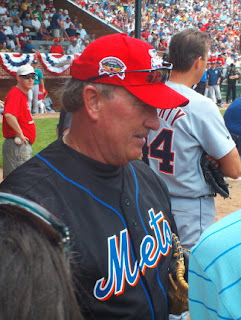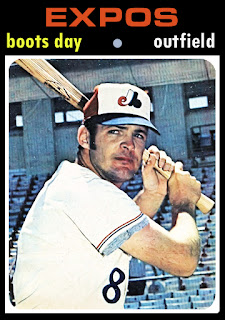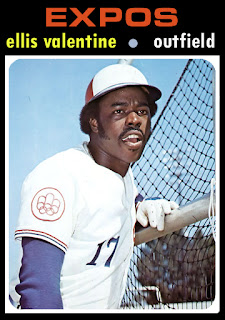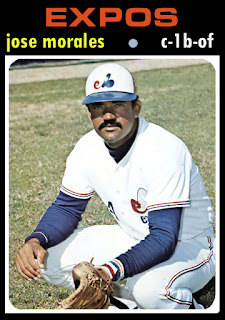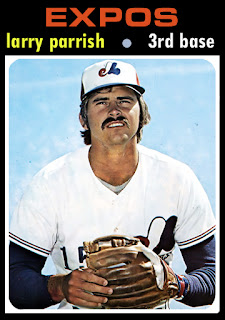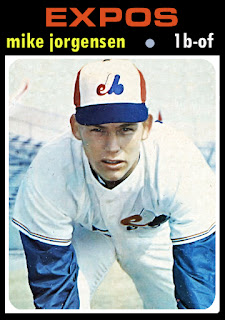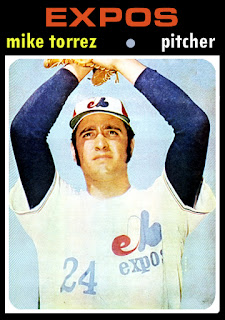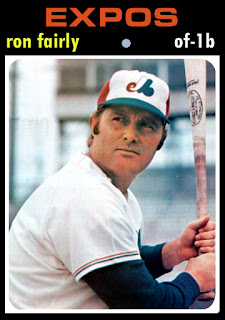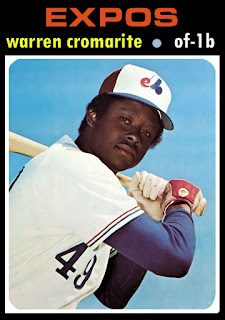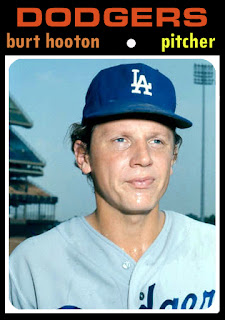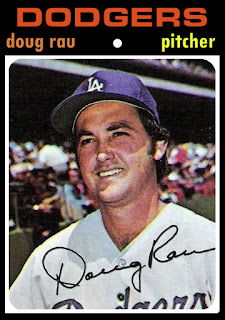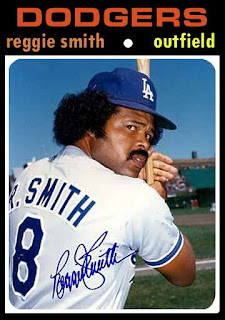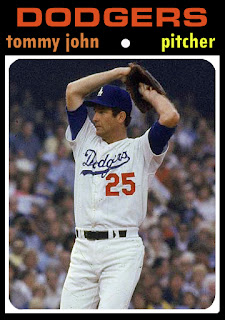After losing 110 games in their maiden voyage (1969) the Expos improved rapidly under Gene Mauch. 1970 saw the 'Spos finish 21 games better than their first season. By 1972 the team was forced to part with its marquee player, Rusty Staub, in order to get a core of young guys to build around. Known as "Le Grande Orange", Staub was an instant fan favorite in Montreal due to his play and his willingness to learn French and adapt to the local customs. Staub was shipped to the Mets in exchange for 3 major league ready talents: Ken Singleton, Tim Foli and Mike Jorgensen. Staub would help the Mets win a pennant in '73, while the young trio he was exchanged for helped the Expos inch closer to respectability. 1973 saw the Expos actual contend for the NL East title. In a year where the Mets would win it all barely over .500 the Expos were only 3 games back finishing 4 games under .500. 1974 and 1975 yielded similar results for the Expos, which led to Mauch's dismissal. While Mauch wasn't able to build a bonafide contender, his managerial skill made the franchise very competitive. His replacement, Karl Kuehl, didn't even survive out the 1976 season as the Expos regressed back to their expansion team ways with 107 losses. Former Oakland A's manager Dick Williams was brought in to right the ship in 1977. Williams began integrating a core group of young players and veteran leader Tony Perez, who the Expos stole from the Reds in the off season. Cincinnati thought "Doggie" was done, so they replaced him with Dan Driessen and shipped him to Montreal for much needed pitching help. The pitchers never panned out for the Reds, but Perez had plenty left in the tank to go along with his steady veteran leadership. 1977 Rookie of the Year, Andre Dawson, took the league by storm. Playing on 2 bad knees his whole career, Dawson still found his way to Cooperstown. He was part of a bumper crop of young studs who were ready to make the jump to the majors. Ellis Valentine was a rifle armed right fielder with 20-20 skills. Warren Cromartie was a solid lefty bat who could play all 3 outfield spots and 1st base. Gary "the kid" Carter, survived being shuttled from right field to catcher and back started his march to Cooperstown under Williams who declared that he was his every day catcher. Carter took Williams' trust and became the face of the franchise as well as the best catcher of his generation. The Expos also found their ace, Steve Rogers, in the mid to late 70's. Rogers would toil night in and night out against the opponents #1 pitcher and somehow early on in his career come up on the short side of a 1-0 or 2-1 loss. By the latter part of the decade he was winning those games consistently and starting to get much needed run support.
1977 marked another milestone in the franchises history. After playing their first 7 seasons in the cozy confines of Jarry Parc the Expos moved into Stadie Olymique'. Many would argue that the lifeless indoor / outdoor cavern was more of a negative than a positive for the franchise and those folks would have some merit to their argument. Leaving behind the intimate surroundings of Jarry Parc gave the franchise huge credibility since Stadie Olympique was a state of the art facility at the time. Along with it came the dreaded AstroTurf that literally took 5 or 6 years off of Dawson's career. Parc Jary, for those who never saw a game there, gave the Expos players a closer bond with the fans. It was quite idiosyncratic, such as the public swimming pool located just beyond the right field wall. During day games when a power hitting lefty stepped up to the plate like Staub or Singleton (a switch hitter) the lifeguard would blow the whistle and have everyone aware that a ball might find it's way into the pool. With Montreal's poor pitching in their early days it was much more likely that a visting slugger like Willie Stargell or Willie McCovey might just deposit a ball in the pool. In fact, legend has it that Stargell did dunk 1 or 2. By 1979 the Expos were now comfortablly entrenched in their new home. The team responded with a 95 win season in 1979, which would go down as the highest win total in franchise history. Unfortunately for fans of Les Expos the Pirates edged the Expos out for 1st place, which would become a pattern for the next few seasons as the Expos were serious contenders in the early 80's but had in 3rd place or higher in 8 of the next 10 seasons. Montreal fans would see their only post season action during the 1981 strike season, which ended sadly in game 5 of the LCS when Dodger Rick Monday hit a huge homer late in the game to give the Dodgers a come from behind victory.
Special thanks must go to Guy Garceau (you may know him as KeonLeafs on the forum), who supplied all of the photos for the 1970's Expos Topps Card update. Guy, a heartbroken Expo fan, has never given up the faith. His Expos might be gone, but he still has his memories and a treasure trove of photos and periodicals that he so graciously scanned and sent to me. Without his help the Expos card set would not look as good as it does.
 It didn't take me more than a day or two to come up with an even better photo for the Gary Carter card. Kid was one of my all time favorite players. He made the game seem fun during an era where players became increasingly unapproachable and surly. Kid always found the time for the fans. His best years were spent in Montreal, where he carved out his HOF niche' as the best catcher of his era, succeeding Johnny Bench. I had the good pleasure to have met him 2 years ago up in Cooperstown for the 2nd annual Father's Day HOF game and parade. After playing 7 innings in the field and obviously tired, he spent the next 30-40 minutes signing autographs and talking to fans. He came over and signed Eric Stouber's son Michael's cap (Mets manager in KOD15). He asked us what our greatest memories were of him as a fan. I think he was shocked when I said, "That day in 1989 in Philly when you went 5 for 5 during his final season as a Met where nothing seemed to go right". I drove down that morning to meet a friend. Kid was hitting about a buck sixty battling injury and bad knees. It was late August and the Mets needed some sort of jump start to get back in the race. I left Veteran's Stadium that day feeling like he turned the clock back and all would be good. After all, this is the guy who got a 2 out in Game 6 of the '86 World Series to hold off elimination. Sadly, it was not going to be Kid's year, nor the Mets year. Both the team and it's aging superstar were no longer the same. Father time marches on and it's neither kind nor gracious to anyone, including the great ones. Kid was one of the great ones. He was a superstar player and a Hall of Fame human being.
It didn't take me more than a day or two to come up with an even better photo for the Gary Carter card. Kid was one of my all time favorite players. He made the game seem fun during an era where players became increasingly unapproachable and surly. Kid always found the time for the fans. His best years were spent in Montreal, where he carved out his HOF niche' as the best catcher of his era, succeeding Johnny Bench. I had the good pleasure to have met him 2 years ago up in Cooperstown for the 2nd annual Father's Day HOF game and parade. After playing 7 innings in the field and obviously tired, he spent the next 30-40 minutes signing autographs and talking to fans. He came over and signed Eric Stouber's son Michael's cap (Mets manager in KOD15). He asked us what our greatest memories were of him as a fan. I think he was shocked when I said, "That day in 1989 in Philly when you went 5 for 5 during his final season as a Met where nothing seemed to go right". I drove down that morning to meet a friend. Kid was hitting about a buck sixty battling injury and bad knees. It was late August and the Mets needed some sort of jump start to get back in the race. I left Veteran's Stadium that day feeling like he turned the clock back and all would be good. After all, this is the guy who got a 2 out in Game 6 of the '86 World Series to hold off elimination. Sadly, it was not going to be Kid's year, nor the Mets year. Both the team and it's aging superstar were no longer the same. Father time marches on and it's neither kind nor gracious to anyone, including the great ones. Kid was one of the great ones. He was a superstar player and a Hall of Fame human being.
